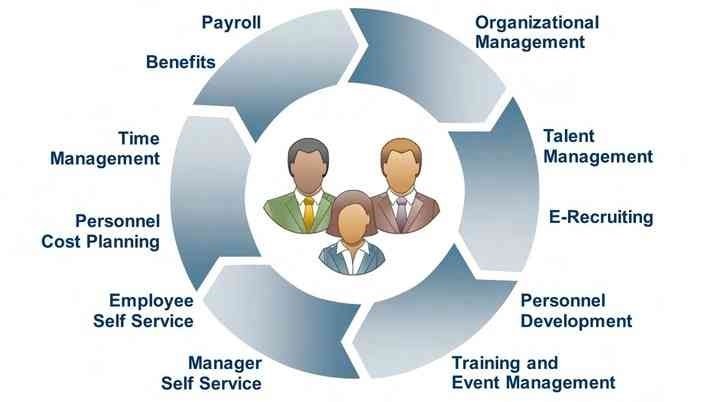In today’s fast-paced business environment, Human Capital Management (HCM) is critical for aligning workforce capabilities with organizational goals and driving productivity. This article explores the foundational concepts of HCM, its significance for business success, and the essential features of modern HCM systems. It also covers future trends in HCM, such as the integration of artificial intelligence and the growing emphasis on employee experience. Real-life case studies will illustrate the tangible impacts of HCM, demonstrating how leading companies have utilized these systems to reduce turnover, boost productivity, and drive overall business growth.
What Is Human Capital Management?
The term human capital management (HCM) describes a group of people resource management techniques. These three practices—workforce acquisition, workforce management, and workforce optimization—are centered on the organization’s requirement to provide specific skills. It’s critical to comprehend how HRM offers a strategic strategy to personnel management, which eventually propels commercial accomplishment. Businesses may cultivate a more engaged and productive workforce by deliberately matching the goals of the organization with the workforce.
Why HCM Matters for Businesses
Efficient human resource management is crucial for organizations as it allows them to optimize their HR procedures and maximize employee performance. This is more crucial than ever in the quick-paced, constantly-evolving corporate world of today. HCM’s talent management component is essential to an organization’s ability to draw in, nurture, and keep top personnel. Productivity, innovation, and general corporate growth are all directly impacted by this. Businesses that invest in human capital management (HCM) are also investing in their most precious asset: their workforce, which fosters long-term growth and gives them a competitive advantage.
Key Features of HCM Systems
HCM systems are designed to optimize human resource management by streamlining the hiring process, monitoring employee performance, providing continuous learning opportunities, implementing fair and competitive compensation packages, and preparing for future workforce needs. These features ensure that organizations find the right fit for their culture and strategic needs, promoting growth and improvement. Regular performance reviews help identify areas for development and recognize top performers. Additionally, proactive workforce planning helps organizations prepare for market changes and reduces the risk of talent shortages. Overall, HCM systems are essential tools for organizations to manage their workforce effectively.
The Benefits of Implementing HCM
Implementing Human Resource Management (HCM) systems can significantly improve employee productivity and engagement, leading to improved company performance. HCM systems offer valuable insights through data analytics, enabling organizations to make informed decisions based on real-time data. Automation and integration of HR processes streamline operations, freeing up resources for strategic initiatives. Effective HCM practices also enhance talent management and retention, reducing turnover costs and preserving organizational knowledge. HCM systems also ensure compliance with labor laws and regulations, reducing legal risks and enhancing the organization’s reputation. Overall, HCM systems contribute to improved employee satisfaction, organizational growth, and compliance with labor laws, ultimately leading to a more prosperous and efficient business environment.
Future Trends in HCM
The future of HCM is promising, with several emerging trends set to shape its development. One key trend is the increasing use of artificial intelligence (AI) and machine learning to enhance HR processes and decision-making. AI in HCM is expected to revolutionize the way businesses manage their human resources, providing deeper insights and automating routine tasks. Additionally, there is a growing focus on employee experience, with organizations investing in tools and strategies to improve overall satisfaction and engagement. Flexible work arrangements, wellness programs, and personalized career development plans are some of the initiatives gaining traction in modern workplaces.
Real-Life HCM Case Studies
Understanding HCM’s impact is easiest through real-world examples. Several companies have successfully implemented HCM systems, reaping significant benefits. For instance, a global tech giant managed to reduce its employee turnover by 20% after adopting a comprehensive HCM solution. This highlights how effective HCM practices can lead to measurable improvements in employee retention and overall business performance. Another example is a retail company that saw a 15% increase in productivity after implementing an HCM system that focused on employee development and performance management. These cases illustrate the tangible benefits of adopting robust HCM practices.
Final Thoughts
The management of human capital is an essential part of contemporary company strategy. Businesses may increase productivity, guarantee compliance, and keep their best employees by investing in efficient HCM solutions. Although there are obstacles, the advantages of HCM exceed the disadvantages by a wide margin, making it a crucial factor for every progressive company. Using HCM techniques promotes long-term company performance and growth in addition to improving personnel management. Companies may build a vibrant workplace that draws and develops the most incredible people, giving them a long-term competitive edge with the correct tactics and resources.
Read More: Pikruos: One-Stop Freelance Business Assistant










